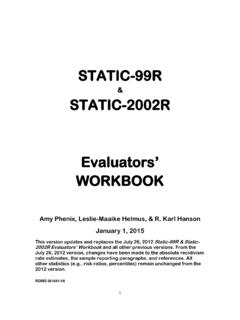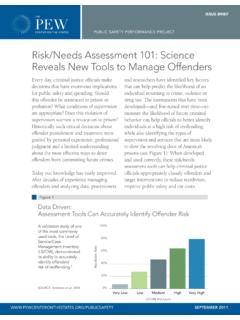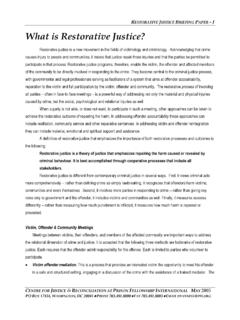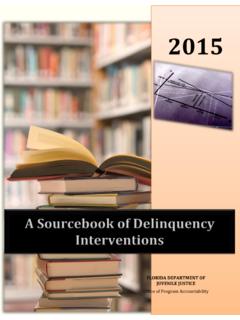Transcription of User Guide for the Brief Assessment for Recidivism …
1 December, 2013 1 User Guide for the Brief Assessment for Recidivism Risk 2002R (BARR-2002R) Kelly M. Babchishin, R. Karl Hanson, & Julie Blais December, 2013 For questions on the BARR-2002R, please contact Kelly Babchishin or R. Karl Hanson For examples on how to present percentiles, hazard ratios, and expected Recidivism rates in your risk communication, see Report Writing for Static-99R and Static-2002R available on this website. Based on a paper presented by K. Babchishin at the 32nd Annual Research and Treatment Conference of the Association for the Treatment of Sexual Abusers, October 30, 2013, Chicago, IL. December, 2013 2 Brief Assessment for Recidivism Risk (BARR-2002R) Description and Purpose The BARR-2002R is an actuarial risk scale for assessing general and violent (including sexual) Recidivism among male sex offenders.
2 The BARR-2002R comprised of a measure of general criminality (the Static-2002R subscale, a risk scale already widely used for predicting sexual Recidivism ) and age at release. The BARR-2002R has been found to predict non-sexual violent, any violent, and general Recidivism significantly better than the Static-2002R total scores. In an independent sample, the BARR-2002R correlated with other risk assessments tools designed to predict general Recidivism and the PCL-R. In addition, the general criminality scale was found to be related to other measures of antisociality ( , PCL-R) and criminality ( , LS/CMI Criminal history scales). The BARR-2002R also predicted general and violent Recidivism as well as more complicated measures specifically designed for these outcomes (LS/CMI, SIR).
3 Given that sex offenders are more likely to reoffend with a non-sexual crime (Hanson & Bussi re, 1998), risk assessments of sex offenders should also include the Assessment of risk for general and violent Recidivism . Even when the focus is exclusively on the risk for sexual Recidivism , it is useful to understand the source of the Recidivism risk. This handout presents the coding sheet for the BARR-2002R and norms for its use. We recommend evaluators use the BARR-2002R for predicting violent and general Recidivism among sex offenders. Target Population The BARR-2002R was developed on a sample of sex offenders and, as such, cannot be used on non-sex offenders. In addition, the sample used to development the Static-99R and Static-2002R were used to develop the BARR-2002R.
4 As such, the BARR has the same target population as these scales. Specifically: (a) Males who have been convicted of a sexual offence (or received an equivalent sanction that qualifies as a sentencing occasion in Item 2 of Static-2002, pages 15-17). (b) Males who committed their most recent sexual offence after their 18th birthday. (c) With caution, males who committed their most recent sexual offence between December, 2013 3 their 17th and 18th birthday, provided that their release date is when they are at least 18. The release date is either the date of release from a closed custody sentence (in Canada, closed custody is analogous to prison) or the date of sentence for a community sentence or open custody sentence (in Canada, open custody is analogous to a halfway house).
5 (d) The cautionary note for (c) does not change even if the juvenile offender was waived into adult court, a procedure allowed in some jurisdictions on some occasion. (e) BARR-2002R is not recommended for use with sexual offenders who committed all of their sexual offences under the age of 17 no matter how old the offenders are at the time of Assessment . (f) It is also not intended for offenders who have been free from violent offences in the community for a period of greater than 8 years since release from their latest sexual offence. This is calculated using street time. ( , if it has been 9 years since the offender s release from his last sexual offence, but he has spent 2 years in prison for a non-violent offence, BARR-2002R can still be used.)
6 If he has been incarcerated for a few short periods for non-violent offences but cumulatively spent 8 years or more in the community, then BARR-2002R is not appropriate for use). (g) BARR-2002R is not recommended for use with individuals whose only sexual crime involves consenting sexual activity with a similar age peer ( , Statutory Rape [a charge]) where the ages of the perpetrator and the victim are close and the sexual activity was consensual (see page 49 for specific rules to make this determination). (h) BARR-2002R is not recommended for offenders whose only sexual offences are Category B offences ( , possession of child pornography, prostitution offences).
7 December, 2013 4 Brief Assessment for Recidivism Risk (BARR-2002R) AGE 1. Age at Release 18 to = 2 35 to = 1 40 to = 0 60 or older = -2 GENERAL CRIMINALITY 2. Any Prior Involvement with the Criminal Justice System No = 0 Yes = 1 3. Prior Sentencing Occasions For Anything: 0-2 prior sentencing occasions for anything = 0 3-13 prior sentencing occasions = 1 14 or more prior sentencing occasions = 2 4. Any Community Supervision Violation: No = 0 Yes = 1 5. Years Free Prior to Index Sex Offence: More than 36 months free prior to committing the sexual offence that resulted in the index conviction AND more than 48 months free prior to index conviction = 0 Less than 36 months free prior to committing the sexual offence that resulted in the index conviction OR less than 48 months free prior to conviction for index sex offence = 1 6.
8 Any Prior Non-sexual Violence Sentencing Occasion: No = 0 Yes = 1 Note. Coding rules for the Static-2002R items are available on December, 2013 5 Samples in Deriving BARR-2002R Norms For all samples, the BARR-2002R was coded retrospectively by summing the general criminality subscale of the Static-2002 and the revised age weight from the Static-2002R. The percentiles and expected Recidivism rates were based on three Canadian samples of routine, relatively unselected sex offenders. Hazard ratios were derived from the Canadian and German samples of routine sex offenders (k = 4). Canadian Samples 1) Canadian federal offenders: Quebec (Bigras, 2007).
9 This study included 94% of all sex offenders receiving a federal sentence in Quebec between 1995-2000 (6% refused participation in the research or were unable to provide consent). 2) Canadian federal offenders: (Boer, 2003). Archival data from the Offender Management System (OMS) maintained by Correctional Service Canada (CSC) were used to identify all federal male offenders serving a sentence for a sexual offense in British Columbia whose Warrant Expiry Date (WED; the end of their sentence) was between January 1990 and May 1994. Many offenders are granted conditional release before their WED; thus, offenders in this sample were released as early as 1986 (n = 296).
10 3) Dynamic Supervision Project (Hanson, Harris, Scott, & Helmus, 2007). This prospective study followed sex offenders on community supervision between 2001- 2005 in all Canadian provinces and territories, and two states. For the current study, only Canadian offenders were considered. Participating probation officers (n = 137) were requested to submit demographic, offense history, and risk Assessment information (Static-99, STABLE-2007, ACUTE-2007) on sex offenders consecutively entering their caseload. The sample can be considered representative of the diverse group of sex offenders on community supervision. German Sample 4) German offenders reported to police (Lehmann et al.















